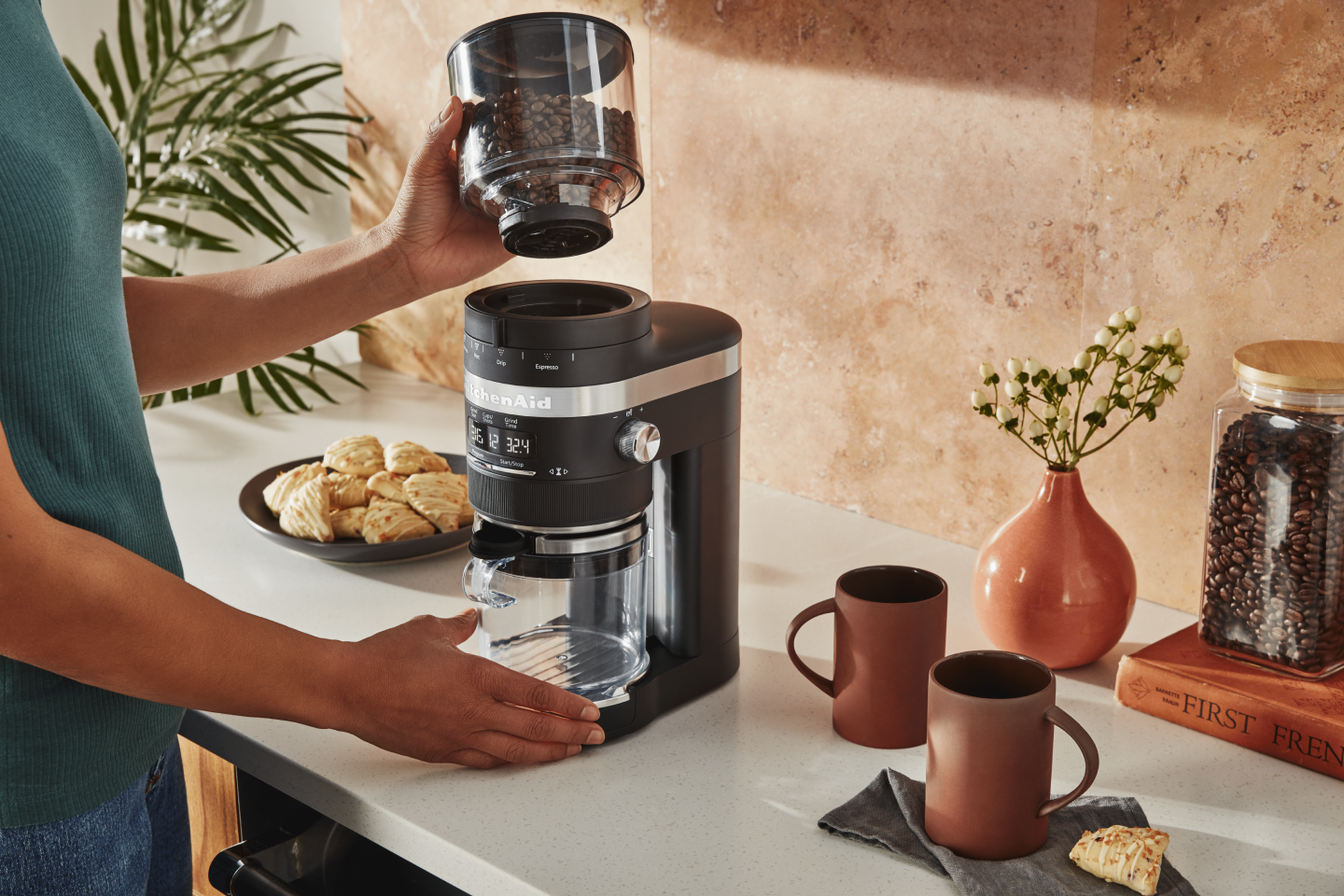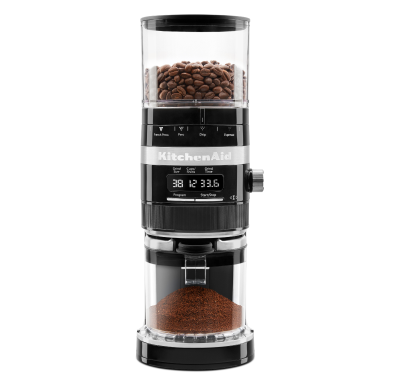
HOW TO GRIND COFFEE BEANS AT HOME
Grinding coffee at home can be a gratifying and important part of the brewing ritual. Not only does it produce a fresh, delicious tasting cup of coffee or espresso, it’s also easy to do with the right tools.
Read on to discover more about why coffee beans that have been freshly and uniformly ground to the size that works best with your preferred brewing method will produce café quality results cup after cup.


WHY SHOULD I GRIND MY OWN COFFEE BEANS?
A great-tasting cup of coffee or espresso starts with freshly ground beans. Not only will grinding coffee at home let you customize the grind size to your brewing method for the most delicious results, it will also help extract the freshest flavors and create a great aroma in your kitchen.
The minute you open a bag of coffee, the beans react with oxygen and begin to degrade. As oxidation occurs, flavors start escaping into the air and coffee beans become stale. In addition, the longer grounds are exposed to the air, the more susceptible they are to absorbing other scents, altering the way brewed beverages taste. Brewing freshly ground beans helps capture a more robust, flavorful cup that retains the subtle nuances of each type of bean and roast. Learn more about how to store coffee beans to keep them fresh.
HOW TO GRIND COFFEE BEANS FOR YOUR BREW
The two most popular ways to grind coffee beans are with a burr grinder or blade grinder. Burr grinders, the gold standard of grinding, pulverize coffee beans with metal burrs while blade grinders chop beans with blades. Both are capable of delivering fresh grounds in a variety of sizes and textures to work with your brewing method.
Manual grinders are another grinding option that doesn’t require electricity to operate, but they do require some elbow grease and may not produce the kind of consistency you’ll find with electric grinders.
KitchenAid brand offers an assortment of coffee bean grinders to create fresh grounds for a variety of café drinks.
SUPPLIES
Coffee Beans
Filtered Water
Cups or Mugs
TOOLS
KitchenAid® Burr Coffee Grinder or KitchenAid® Blade Coffee Grinder
KitchenAid® Coffee Scoop or scale for measuring beans
Measuring spoons

STEP 1: CHOOSE YOUR BREWING METHOD
Once you determine which brewing method you’ll be using—cold brew, espresso, auto drip, etc—you’ll be able to determine which coffee grind size to use. In general, slower, hotter immersion brewing methods require coarser grinds, while quicker extraction methods use finer grinds.

STEP 2: DETERMINE THE SIZE AND GRIND YOU NEED
Understanding how coffee grind size and texture impact different brewing methods is key to creating a robust cup. How long your grounds are in contact with water during the extraction process will help determine how weak or strong your drink is. If your grounds are too fine for your brewing method, your drink could be over extracted, resulting in an overly bitter taste. If your grounds are too coarse, the water will move through them quickly and you’ll get acidic, under extracted results.
Matching Coffee Grind Types and Sizes to Brewing Method:
Extra Coarse/Coarse (ground peppercorns/sea salt): Best for cold brew coffee or other long, slow immersion processes.
Medium Coarse (rough sand): Best for French Press and other hot immersion methods
Medium (sand): Best for auto drip and pour overs. Learn about the differences between drip and pour over coffee.
Fine (table salt/sugar): Best for pressurized brewing methods with shorter brew times like espresso, Cuban coffee or Moka Pot
Extra Fine (powder/flour): Best for Turkish coffee

STEP 3: CHOOSE YOUR GRINDING METHOD
If you’re looking for the best way to achieve a precise grind size, a burr grinder is the way to go. This will give you the control you need to produce the consistency that’s especially important for grinding coffee for espresso machines, or other pressure and quick extraction methods of brewing. The KitchenAid® Burr Coffee Grinder offers 70 precise settings to match the right grind size to your brew method.
A blade grinder can be used for cold brew or other longer immersion processes, but tends to have limited settings and offers less consistency. This goes for manual grinders, as well. If you’re really in a pinch a mortar and pestle will work for brew methods requiring coarser grounds, but again, consistency can be an issue with this type of method.

STEP 4: MEASURE BEANS/DETERMINE DOSING
There are several methods for measuring beans, but the most accurate is measuring by weight. For the most exact results, weigh beans before you grind them on a kitchen scale. As a rule of thumb, you'll need two tablespoons of ground beans for every 6 ounces of coffee. This is approximately 0.38 oz. or 10.6 g. of whole coffee beans. If you don’t have a scale, 4 tablespoons of coffee beans will produce about three and a half teaspoons of grinds.
If you’re making espresso, you’ll need about 1.5-2 teaspoons of ground beans for 1-1.5 fluid ounces of espresso.
You can take the guesswork out of measuring/dosing with the KitchenAid® Burr Coffee Grinder. The Automatic Smart Dosing Technology feature is designed to allow you to select the cups or shots desired, grind-time is adjusted accordingly, regardless of grind size or brew method.

STEP 5: DETERMINE GRINDING TIME
The longer the grind time, the finer the coffee grounds. Conversely, a coarse grind will require a shorter grind time. Electric coffee grinders make relatively quick work of grinding for both fine and coarse grounds. Keep in mind that a blade grinder, although very fast, may need to be stopped a couple of times in the grinding process to check progress and shake loose any stray beans that may have gotten caught in the blades. Timing isn’t an issue with burr grinders because the grind size is determined by the adjustment of the burrs.
SHOP KITCHENAID® COFFEE GRINDERS
Whether you’re looking for the versatility, precision and control of a burr grinder, or the speed and one touch operation of a blade grinder, KitchenAid brand has the right grinder for the way you create.


HOW DO YOU GRIND COFFEE BEANS WITHOUT A GRINDER?
It is possible to grind coffee beans without a grinder by using a mortar and pestle, rolling pins or a meat mallet. Unfortunately these methods just won’t do if your goal is to achieve consistent coffee grind size, which is particularly important for brewing certain coffee and espresso drinks.
CAN YOU GRIND COFFEE BEANS IN A BLENDER?
Blenders are designed to work with some amount of liquid, so grinding coffee beans in a blender isn’t an ideal option. Some high-powered blenders have the ability to grind coffee beans but they’re likely unable to produce consistent grind sizes and textures.
CAN YOU GRIND COFFEE BEANS IN A FOOD PROCESSOR?
Food processors aren’t a great choice for grinding coffee beans because their motors aren’t designed to take on hard ingredients and their blades aren’t suited to creating consistently sized grounds.
CAN YOU GRIND COFFEE BEANS WITH A MORTAR AND PESTLE?
It’s possible to grind coffee beans with a mortar and pestle, but there are potential pitfalls, including consistency of grind size and over grinding portions of beans. If beans are overground they can over extract flavor, creating a bitter brew.


HOW LONG DO YOU GRIND COFFEE BEANS?
It usually takes less than 30 seconds to grind coffee beans in an electric grinder. However, the secret to perfectly ground coffee isn’t time but a combination of grind size and uniform grounds. Different grinding methods will require different lengths of time to achieve the right size and consistency. The finer the grinds and the larger the quantities, the longer the grinding time.
Blade grinders can work very quickly. You can achieve a medium coarse/medium grind for an automatic drip coffee maker, or a French press, in as few as 14-21 seconds in a KitchenAid® Blade Coffee Grinder. It’s important to note that longer grinding times can quickly overheat the coffee beans and valuable flavor can be lost.
Once you select your brewing method, dosing and grind size, the KitchenAid® Burr Coffee Grinder will automatically determine the grinding time for you.
EXPLORE KITCHENAID® COFFEE GRINDERS, ESPRESSO MACHINES & MORE
Freshly ground coffee beans can be the difference between a good cup of coffee or espresso and an exceptional café quality drink. The KitchenAid® Coffee Collection features all the latest brewing tools you need—including coffee bean grinders—with innovations to help you brew with more creativity than ever.